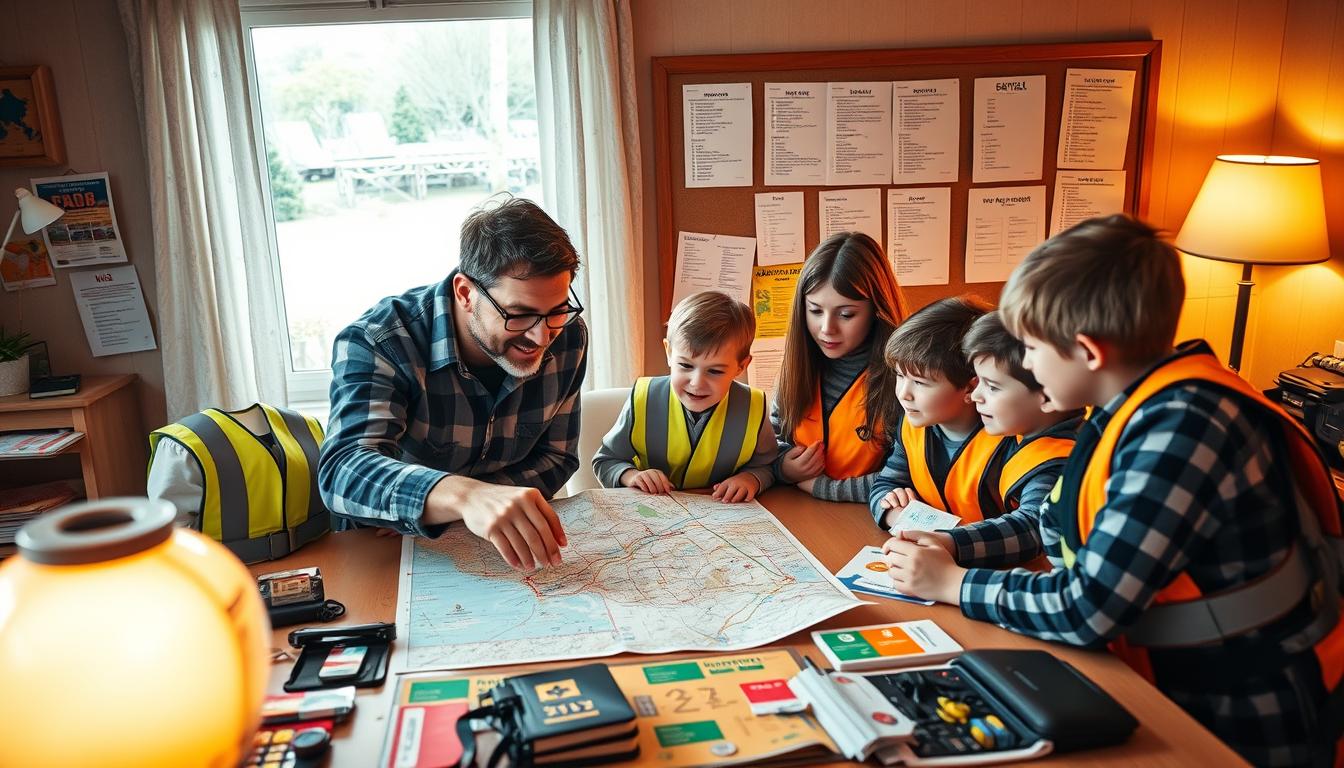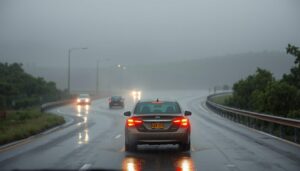Road Trip Safety Tips for Families
Did you know that drowsy driving is a factor in up to 21% of fatal traffic accidents? This startling fact from the AAA Foundation highlights a critical risk for anyone behind the wheel for long hours.
Family journeys are fantastic for creating lasting memories. Exploring new places together strengthens bonds. But a successful adventure hinges on smart planning.
A well-prepared trip minimizes stress and unexpected problems. It ensures a smoother, more enjoyable experience for everyone from start to finish. Proper preparation is the best way to keep your loved ones secure.
This guide covers all the essential things you need to know. We will help you prepare your vehicle, plan your route, and pack wisely. Our goal is to maximize your quality time together.
With the right approach, you can turn a long drive into a wonderful adventure. These practical tips will help you navigate the open road with confidence. Let’s make your next family trip both safe and incredibly fun.
Key Takeaways
- Drowsy driving is a major factor in a significant percentage of fatal crashes.
- Proper preparation is the foundation of a smooth and enjoyable family journey.
- Safety involves more than just your vehicle; it includes route planning and smart packing.
- A well-planned adventure reduces stress and prevents unexpected delays.
- The right mindset and preparation can transform a long drive into a memorable experience.
Prepare Your Vehicle for a Smooth Journey
Before setting out on any family excursion, giving your car a thorough check-up is essential. Taking this time upfront prevents unexpected issues later. A well-maintained vehicle ensures everyone travels comfortably.
Vehicle Maintenance Checklist
Start with basic inspections you can do yourself. Check tire pressure and tread depth for optimal performance. Test all lights including headlights and brake signals.
Top off essential fluids like oil and coolant. If you’re unsure about any checks, visit a trusted mechanic. They can spot potential problems early.
| Inspection Area | What to Check | Frequency |
|---|---|---|
| Tires | Pressure, tread depth, rotation | Before each long journey |
| Fluids | Oil, coolant, brake fluid levels | Weekly and pre-trip |
| Lights | Headlights, taillights, turn signals | Monthly and before departure |
| Brakes | Response time, pad wear | Professional check every 6 months |
Essential Emergency Car Supplies
Every vehicle should carry basic emergency items. Jumper cables can restart a dead battery quickly. A properly inflated spare tire is crucial for flat repairs.
Keep a well-stocked kit in your trunk at all times. Include a flashlight, first aid supplies, and basic tools. These supplies provide peace of mind on the road.
Map Out Your Route and Plan Ahead

Modern navigation tools have revolutionized travel, but a solid plan remains your most reliable co-pilot. A clear route minimizes wrong turns and maximizes family fun.
Smart planning gives you the freedom to adapt. You can enjoy spontaneous detours while staying on track toward your destination.
Utilizing Mobile Apps for Navigation
Start by mapping your general route with an app like Google Maps. It helps estimate driving time and find ideal stopping points.
Always download your directions for offline use. Cell service can vanish in rural areas. Having a saved map prevents getting lost.
Considering Alternate Routes and Stops
Identify several rest places for each day. Research fuel, food, and lodging options ahead of time. This idea lets you stop early if fatigue sets in.
Keep alternate routes in mind for traffic or closures. A flexible plan is a safe one.
| Navigation Tool | Primary Use | Key Advantage |
|---|---|---|
| Google Maps App | Real-time directions | Offline map downloads |
| AAA TripTik | Printed route backup | Reliable without signal |
| Paper Map | Emergency backup | Broad geographic overview |
Finally, share your full itinerary with someone not on the trip. They can help if an emergency arises on the road.
Check and Update Your Insurance and Registration
Having your paperwork in order might not be the most exciting part of vacation preparation, but it’s absolutely essential for peace of mind. Proper documentation protects your family during travel and provides quick assistance when needed.
Gathering Important Documents
Before your next family adventure, make sure all essential papers are current and accessible. Verify that your car insurance and registration won’t expire during your trip.
Keep physical copies in your glove compartment for easy access. Include insurance cards, vehicle registration, and roadside assistance membership details.
| Document | Location | Status Check |
|---|---|---|
| Car Insurance Card | Glove Box & Mobile App | Valid for entire journey |
| Vehicle Registration | Glove Box | Not expiring during travel |
| Driver’s License | Wallet & Digital Copy | Current and valid |
| Roadside Assistance | Mobile App & Card | Active membership |
Also save digital copies on your phone or cloud storage. This backup saves valuable time in case you need assistance quickly.
Download helpful apps like the AAA Mobile App for instant access to your insurance information. Having everything organized reduces stress and keeps your focus on enjoying the journey.
Pack Smart and Build Your Emergency Kit

Your vehicle’s trunk holds more than luggage—it can store peace of mind for unexpected situations. Smart packing means bringing essential items without overloading your car. This approach maintains good fuel economy while keeping your family comfortable.
A well-organized emergency kit transforms potential problems into manageable situations. Focus on items that enhance both safety and comfort during your journey.
Must-Have Roadside Supplies
Store your emergency supplies in an easily accessible trunk location. Critical items include jumper cables or a portable jump starter for battery issues. Always include a flashlight with fresh batteries and a complete first aid kit.
Don’t forget basic tools and a properly inflated spare tire. These essentials can handle most common vehicle problems you might encounter.
| Supply Category | Essential Items | Storage Location |
|---|---|---|
| Emergency Tools | Jumper cables, flashlight, basic tools | Trunk organizer |
| Safety Equipment | First aid kit, warning triangle, duct tape | Easy-access side compartment |
| Comfort Supplies | Water bottles, non-melting snacks, blankets | Within reach in cabin |
Preparing Your Car Safety Kit
Consider weather conditions when building your safety collection. For summer travel, include sunscreen, sunglasses, and plenty of water. These items protect against harsh sunlight during unexpected delays.
Cold-weather journeys require thermal layers, warm blankets, and hand warmers. Always check forecasts before and during your adventure.
Proper preparation prevents poor performance—especially when traveling with family.
Keep snacks like granola bars and dried fruit readily available. They provide energy if you’re waiting for assistance. Organize frequently used items within easy reach while storing emergency gear securely.
Road Trip Safety: Driver Tips and Healthy Habits

Your attention and alertness as the operator of the vehicle create the foundation for protected travel. Smart driving practices keep everyone secure during long journeys.
Conscious habits behind the wheel make all the difference. They ensure smooth progress toward your destination while minimizing risks.
Switching Drivers to Avoid Fatigue
Rotating driving duties every two to three hours prevents exhaustion. This approach keeps both operators fresh and attentive.
Most people handle four to seven hours comfortably each day. Know your personal limits and respect them for maximum security.
Staying Focused on the Road
Eliminate distractions like phone use or eating while operating the vehicle. Keep both hands on the wheel and eyes on the path ahead.
Practice defensive techniques by anticipating other vehicles’ movements. Maintain safe distances and always have an escape route in mind.
| Driving Habit | Benefit | Frequency |
|---|---|---|
| Driver Rotation | Reduces fatigue, maintains alertness | Every 2-3 hours |
| Defensive Driving | Anticipates hazards, prevents accidents | Continuous practice |
| Distraction Elimination | Improves reaction time, enhances control | Throughout journey |
| Proper Seatbelt Use | Protects all occupants during incidents | Before starting vehicle |
If drowsiness sets in, pull over immediately. It’s better to arrive late than risk an accident due to fatigue.
Stay Alert with Regular Breaks and Stretching

Your body needs movement just as much as your vehicle needs fuel. Planning stops every couple of hours keeps everyone comfortable during long drives. This approach prevents fatigue and maintains focus throughout your journey.
Importance of Rest and Refreshment
Scheduled pauses serve dual purposes for travelers. They provide physical relief from sitting and mental refreshment from monotony. Aim for breaks every two hours or 100 miles.
Use these stops to walk around your vehicle. Check tires for debris and ensure everything looks normal. Early detection prevents bigger problems later.
Simple On-the-Road Exercises
Quick movements boost circulation and alertness. Try jumping jacks or knee raises during breaks. Shoulder rolls and stretching combat stiffness from sitting.
These activities take just a few minutes. They provide a gentle wake-up without exhausting you. It’s a good idea to involve the whole family.
| Break Activity | Physical Benefit | Time Investment |
|---|---|---|
| Walking around vehicle | Leg circulation & safety check | 3-5 minutes |
| Jumping jacks | Full-body wake-up | 1-2 minutes |
| Shoulder stretches | Upper body relaxation | 2 minutes |
| Deep breathing | Mental refreshment | 1 minute |
If fatigue sets in, don’t push through. A 20-minute nap can restore focus significantly. Keep windows down for fresh air and have plenty of water available.
Remember that breaks aren’t wasted time. They’re an investment in everyone’s well-being during travel hours. This way, you arrive refreshed rather than exhausted.
Keep Pets Safe on the Road
Traveling with animal family members transforms a routine trip into a shared experience that demands extra planning. Proper preparation ensures your furry companions stay comfortable and secure throughout the journey.
Before departure, make sure all vaccinations are current. Pack copies of records in case you need them. Ensure pets wear collars with ID tags containing your cell number.
Securing Pets with Harnesses or Carriers
Always use appropriate restraints for your pets during travel. Smaller animals do well in carriers, while harnesses work for dogs. These keep pets secure in the vehicle.
Place all animals in the back seat. The front passenger area poses risks from airbag deployment. Proper restraint prevents pets from becoming projectiles during sudden stops.
Essential Pet Travel Items
Pack familiar items to reduce anxiety. Bring regular food, treats, and bottled water. Include a portable bowl and waste disposal bags.
Don’t forget comfort items like favorite toys or blankets. Plan stops every two hours for bathroom breaks and fresh air. Research pet-friendly accommodations ahead time.
Never leave pets alone in parked cars. Temperatures rise dangerously fast, even with windows cracked. With careful planning, your animal companions can enjoy the adventure safely.
Adapting to Weather and Road Conditions
The sky above can be your greatest ally or biggest challenge during family travel. Staying informed about changing conditions helps you make smart decisions throughout your journey.
Check extended forecasts for your entire route before departure. Download a reliable weather app and monitor it regularly. This preparation allows you to adjust timing or choose alternate paths when needed.
Checking Weather Before and During Travel
Severe weather warnings require immediate attention. Winter storms can make highway travel impossible, even in southern states. Heavy rain, extreme heat, or high winds demand careful planning.
Having backup routes is always a good idea. Sudden storms may appear without warning. Being ready to pull over safely protects everyone when conditions deteriorate.
Driving Safely in Various Conditions
Different weather demands different approaches. Reduce speed and increase following distance during rain, snow, or ice. Use low-beam headlights in foggy situations.
High winds require extra caution, especially with taller vehicles. Adjust your driving for sudden changes in traffic patterns too.
| Weather Condition | Driving Adjustment | Preparation Items |
|---|---|---|
| Rain/Wet Roads | Reduce speed, increase distance | Quality wipers, defroster |
| Snow/Ice | Slow gradual movements | Snow chains, ice scraper |
| Fog | Low beams, reduced speed | Fog lights, emergency flashers |
| High Winds | Firm steering, reduced speed | Secure cargo, plan route |
Pack appropriate supplies for anticipated conditions. Sunscreen, extra layers, or umbrellas handle most situations. Remember that being prepared makes all the difference.
Manage Road Trip Costs and Expectations
Financial preparation is the unsung hero of memorable family travels, allowing you to focus on creating lasting memories. A realistic budget prevents stress and ensures you have funds for both planned stops and spontaneous discoveries.
Budgeting for Fuel, Snacks, and Stops
Start by estimating major expenses using online tools. Calculate fuel costs based on your vehicle’s mileage and current prices. Include lodging, meals, and attraction fees in your planning.
It’s a good idea to research discounts available through memberships like AAA. These savings can add up significantly over multiple days. Pack your own snacks and drinks to avoid expensive convenience store purchases.
| Expense Category | Planning Strategy | Cost-Saving Tip |
|---|---|---|
| Fuel | Calculate based on route distance | Use apps to find lowest prices |
| Meals & Snacks | Budget for 3 meals daily | Pack homemade options |
| Lodging | Research options along route | Book ahead for better rates |
| Entertainment | Identify free/paid attractions | Use membership discounts |
Avoiding Overpacking and Unnecessary Expenses
Overloading your vehicle strains the engine and reduces fuel economy. Pack strategically to maintain passenger comfort and space. Bring essential things without going overboard.
Secure accommodations ahead time when traveling with specific needs like pets. While spontaneous lodging can be adventurous, planning ensures availability and better rates. Leave room in your budget for unexpected delights along the way.
Conclusion
Creating lasting bonds through shared adventures requires more than just packing bags—it demands careful planning for everyone’s well-being. The best family journeys combine spontaneous fun with thoughtful preparation.
Following these comprehensive safety tips ensures your vehicle is ready for any challenge. Proper planning transforms potential stress into smooth, enjoyable travel experiences.
Remember to stay safe by taking regular breaks and staying alert behind the wheel. Keep these important measures in mind throughout your journey.
With the right approach, every season becomes perfect for family adventures. Make sure to enjoy the spontaneous moments while prioritizing security. Your next excursion will create wonderful memories that last a lifetime.
FAQ
What are the most important things to check on my car before leaving?
What should I pack in an emergency kit for my vehicle?
How can I plan my route to avoid heavy traffic?
What documents do I need to have with me while driving?
How often should we take breaks during a long drive?
What’s the best way to keep my pet safe in the car?
How should I drive if I encounter bad weather?
Any tips for managing costs on a long journey?

Eduard Kingly is a travel and lifestyle content creator with a focus on personal development and education. He combines firsthand travel experiences with research-driven insights to guide readers in discovering new places, building better habits, and pursuing meaningful learning.




